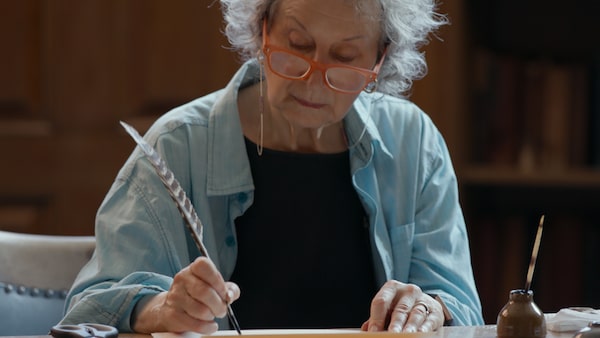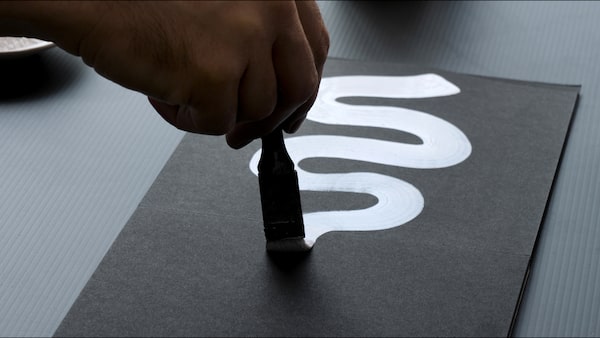
Jason Logan in his home studio, in a scene from Brian D. Johnson's documentary The Colour of Ink.Brian D. Johnson/Courtesy of the National Film Board of Canada and Sphinx Productions
At a press conference in Cannes, Quentin Tarantino was asked why he didn’t use composers. To which he replied, “The music is the soul of my film. Why would I entrust that to a composer?”
Documentary filmmaker and former Maclean’s movie critic Brian D. Johnson understands the sentiment. “Nowhere does a director relinquish more control of a film than to a composer,” he says. So for his new film, The Colour of Ink, an elegant profile of Toronto inkmaker and illustrator Jason Logan, he decided not to use a typical film scorer. Instead, he tapped Don Kerr, a well-known indie-rock drummer and producer.
Johnson was also heavily involved in the choices of licensed songs and recordings, including k.d. lang’s The Air That I Breathe, Leonard Cohen’s Who By Fire and a medley of Joni Mitchell’s Blue, Miles Davis’s Green in Blue and George Gershwin’s Rhapsody in Blue. The filmmaker and his musician collaborator spoke to The Globe and Mail about the process of setting music to film.
Brian, can you talk about what led you to choose Don to score the film?
Johnson: What I wanted to avoid was an auteur composer who just gives me their signature score. I wanted somebody who could create from the ground up, and who wouldn’t mind me getting my hands dirty with him or her and the music. Don was willing to do that, and he seemed immensely qualified.
What effect did Jason Logan’s art and ink-making process have on the film score?
Kerr: For me, the visual and artistic and even spiritual aspect of Jason’s art and this film is so deep that it defies words. So I wanted to make music the way Jason makes his ink look. I started foraging sounds and taking regular sounds and slowing them down six times and doing all kinds of interesting things to try to get different colours for a palette, like really deep, low sounds for the dark sections, and more atmospheric and abstract sounds than I’ve ever used before.
Johnson: Jason is all about working with primal ingredients. It’s about the ingredients on some level and where they come from.
Kerr: My favourite thing about the inks is how they fight the different materials. They fight on the page. They don’t necessarily blend together the way you’d expect. And they create.
You could be speaking about being in a band, with the fighting.
Kerr: Sure. The dissonance brings out the goal. The elements push against each other, driving everything into madness, and then something brand new.
Johnson: Well, a band without conflict and abrasion and blood is not really a band.
Brian, what role did you play in creating the score?
Johnson: Just sort of helping to kind of find the sweet spots and the spaces in the film where I see how the music sits. It was illuminating and very exciting, particularly the real-time aspect of it. A lot of the beauty of the film to me is about real-time improvisation with Jason on camera, whether he’s foraging or whether he’s making ink. He’s kind of like an actor improvising. He’s just waiting to see how the ink is going to behave.
Don, were you able to create music in that same kind of organic way?
Kerr: I tended to improvise and come up with sketches. I’ve done some other film scores, not that many, but a few. And I keep discovering more and more that composing for a film is kind of like overdubbing extra things onto the visuals. You’re not trying to create a magnum opus like an old film from the 1940s with a symphony playing. It’s too cumbersome – its format is too big. You’re basically treating what you’re looking at.
What about the licensed music?
Johnson: I spent double the licensing budget. My co-producers thought I was out of my mind. I had to pilfer from the rest of the budget to find the money. I tried to license Paint it Black by the Rolling Stones. But when it starts at $50,000 just for the song itself, never mind for the master recording, you can sort of forget about that. Just as well, I think.
What about the choice of Leonard Cohen’s Who by Fire as the second song in the closing credits?
Johnson: I’ve had Leonard Cohen’s words and music in all four of my films, the two shorts and two features. But I encountered some resistance. I was told nobody sits around for the closing credits, especially at the end of the closing credits. I said, “Well, film programmers do, and film critics do.”
This interview has been condensed and edited.

Margaret Atwood writes with a quill at Wycliffe College in Toronto.Courtesy of the National Film Board of Canada and Sphinx Productions
Critic’s Pick
- The Colour of Ink
- Directed by Brian D. Johnson
- Starring Jason Logan, Margaret Atwood
- Classification G; 105 minutes
- Opens in theatres March 23
To a newspaper reader, ink is something to wash off your hands when the reading is done. To Toronto inkmaker, illustrator and seeker Jason Logan, ink is eternal, primal and spiritual. “In the bottle it’s a colour, and when it hits the paper it’s a sort of process,” he says in Brian D. Johnson’s poetic, aqueous The Colour of Ink.
The National Film Board doc, which plays in cinemas across Canada starting this week, follows Logan’s perpetual quest for the fluid and its meaning. He makes ink from just about anything, including rusted railroad spikes and carbonized peach pits. There’s another guy who uses antique pawnshop pistols.
Director Johnson, whose last effort was 2015′s Al Purdy Was Here, takes us to Japan and other interesting places. A calligrapher brushes epically; a tattooist searches for the blackest black; a Haida carver decorates a cedar mask; Margaret Atwood wields a quill.
T.S. Eliot said the purpose of literature is to turn blood into ink. All about the alchemy, The Colour of Ink metaphorically mingles ink with blood too, mystifying its topic. That the fluid is alive and precious is the point. Brad Wheeler

Logan tests ink made from drywall dust.Courtesy of the National Film Board of Canada and Sphinx Productions
 Brad Wheeler
Brad Wheeler